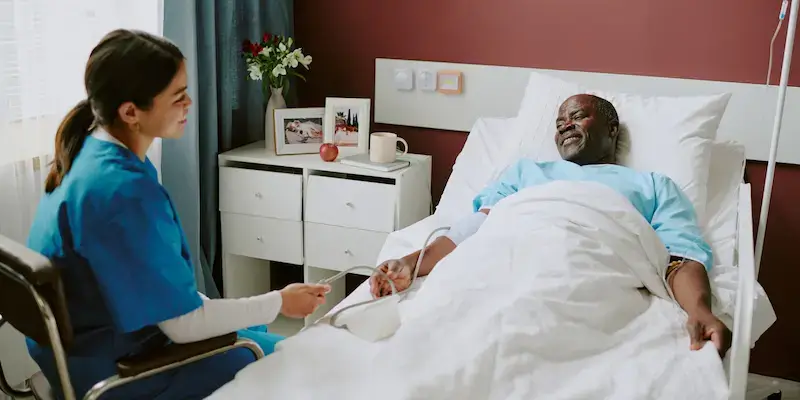Home >
Musculoskeletal ultrasound injection (steroid)
Get rapid access to our leading specialists.
This page aims to answer some of the questions you may have about having a musculoskeletal injection. It explains the recent changes to the injection, benefits, risks and alternatives to the procedure. It explains what you can expect when you come to hospital. If you have any further questions please speak to your consultant or the imaging department.
What is a musculoskeletal injection?
A musculoskeletal injection is an injection into joints (articular) or in soft tissue structures around joints (peri-articular) to relieve pain, reduce inflammation, and improve mobility. A radiologist will inject a corticosteroid (and some local anaesthetic) to reduce inflammation and alleviate pain.
What is an ultrasound guided musculoskeletal injection?
An ultrasound scan is where sound waves are used to build pictures of the body when reflected back of different structures. The sound waves travel through a hand-held sensor which is moved over your skin with the aid of some gel. Therefore, ultrasound is used to guide the radiologist to the exact point where the injection is needed to ensure accuracy. Commonly used steroids for these injections are Kenolog and Depo-Medrone.
What are the benefits of having a steroid injection?
The main benefit of having a steroid injection is to treat inflammation (swelling) and pain arising from or around a joint, tendon or soft tissue. This can also aid in the range of moment of the joint.
Are there any risks or side-effects of the steroid injection?
This is a common procedure and very safe when performed in a controlled setting. However, some risks of this injection include:
- Immune system temporarily suppressed – this can potentially increase your risk to viruses
- Infection – there is always a risk of infection with any injection but this is minimized by following a sterile procedure
- Pain – the steroid injection can make the pain or discomfort temporarily worse, which is called a ‘Steroid Flare’. This can be more painful for approximately 2-3 days after injection. You may take your regular pain killers to provide relief during this time.
- Discolouration – Very rarely a white dot or patch on the skin can appear after the injection which can last a few months
- A dent in the skin at the site of injection
- Skin thinning or skin dimpling – occasionally the skin overlying the injection site may become thinned
- Tendon rupture – very rare but steroids may weaken the tendon so it is important to avoid any strenuous activity or exercises for 3-4 weeks and use splints or support, if provided
- Allergic reaction
- No benefit – the injection may not help your symptoms at all
- Diabetes – can cause blood sugar levels to elevate temporarily
- Hot flushes and irregular menstrual periods
The radiologist will go through the risks and side effects in more detail before your procedure and you will be able to ask any questions you may have then.
If you are or if you think you could be pregnant, if you have had any allergic reaction to local anaesthetic in the past, you must tell your referring doctor and the Imaging team.
Are there any alternatives?
The alternative to injections would have been discussed with you by your referring clinician, as would have been the option of not having an injection. However, if you have any further concerns or your condition has changed, please let us know.
Consent – asking for consent
The radiologist will ask you if you are happy for the injection to go ahead. You will be asked to sign a consent form which states you agree to have the injection and understand what it involves. If you do not wish to have the injection or are undecided, please tell the radiographer/ radiologist.
It is your decision and you can change your mind at any time. Please remember that you can ask the radiologist any questions you have at any time before, during or after your procedure.
What do I have to do in preparation for the scan?
In many cases you do not need to do anything to prepare for the scan. You can take all of your medication as usual. If you are on any anti-retroviral medication or have allergies, please let us know before your appointment. Please have your travel home planned.
What do I need to wear?
Please wear clothes that are easy to remove, as you will be required to change into a hospital gown before you have your injection. This is to ensure a sterile procedure.
What happens during the procedure?
Before the injection takes place, you will be given the opportunity to ask the radiographer any questions you have. You will be asked to get changed into a hospital gown and remove any clothing around the site being injected. The radiologist will go through a consent form, check any allergies and explain the procedure and answer any questions you may have.
You will then sit or lie down on the bed and the radiologist will do an ultrasound of the area of interest. The radiologist will clean the injection site and then may inject a small amount of local anaesthetic to numb the area which may sting for a few seconds. Once this has taken effect, a needle will be placed into the site under ultrasound guidance. Once the radiologist is happy that the tip of the needle is in the correct place, the injection will be given.
How long will the procedure take?
The procedure usually takes about 30 minutes, however it is patient dependant. You can leave the department after the injection as long as you feel comfortable enough.
Will there be anyone with me during the scan?
The healthcare assistant and radiologist will talk to you through what’s going on during the procedure. A relative can be in the room for the injection if necessary.
Can I bring my children?
Unfortunately we are not able to offer childcare facilities and your children cannot go into the scan room with you. If you need to bring your children with you, please bring along an adult who can look after them while you are having the examination.
What happens afterwards?
Immediately after the injection, you may feel that your pain has gone or is significantly reduced. This is due to the local anaesthetic and will last for a few hours.
After the local anaesthetic has worn off you may experience a worsening of your usual symptoms. In the following 2-3 days you may get a worsening of your symptoms, which is called a steroid flare. You can take normal pain medication to help. The symptoms usually improve about three days after the injection but this varies from patient to patient. The benefits of the injection may last for a few weeks or months. You may need more than one injection to settle the symptoms. Please speak to your referring doctor if you have any queries after your injection.
Please fill in the pain chart if you are given one at the end of the procedure. You can download or print this information here.
Need further help or advice?
Contact our team for enquiries or information.
If you need to contact us in any other way, please go to

